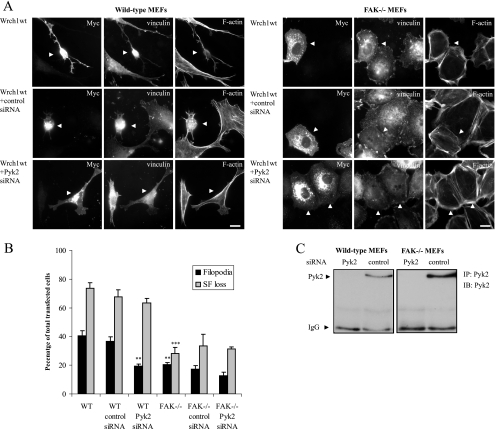FIG. 6.
Pyk2 and FAK are required for the Wrch1-induced filopodium formation or stress fiber dissolution. (A) Myc-tagged wild-type Wrch1 (Wrch1wt) was transfected into normal MEFs or MEFs isolated from FAK−/− mice in the presence or absence of Pyk2-specific siRNA or control siRNA. Myc-tagged Wrch1 was detected by a rabbit anti-Myc antibody followed by an AMCA-conjugated anti-rabbit antibody. Vinculin was detected by a mouse antivinculin antibody followed by a TRITC-conjugated anti-mouse antibody. Filamentous actin was detected by Alexa Fluor 488-conjugated phalloidin. The arrowheads mark transfected cells. Bar, 20 μm. (B) Quantification of the phenotypes observed in panel A was performed by microscopy analysis and scored as filopodium formation (filopodia) or stress fiber dissolution (SF loss). The values represent analyses of at least 100 transfectants in three independent experiments. The statistics analysis was carried out using Student's t test to compare the phenotypes induced by Wrch1 in the presence of control siRNA and Pyk2-specific siRNA or the Wrch1-induced phenotypes in FAK−/− and wild-type MEFs. * represents P values of <0.05, ** represents P values of <0.01, and *** represents P values of <0.001. (C) Transfection of siRNA specific for Pyk2 leads to a knockdown of Pyk2 expression in wild-type and FAK−/− MEFs. The expression of Pyk2 is rather low in these cell lines; therefore, Pyk2 was immunoprecipitated (IP) with a Pyk2-specific antibody and the presence of Pyk2 in the precipitates was detected by immunoblotting (IB) using a Pyk2-specific antibody. IgG, immunoglobulin G.

